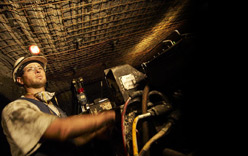Water
Large quantities of water are used in mining
operations for cooling machinery, dust suppression, cleaning, fire-fighting and
drinking. Water supplies are normally carried in steel pipes from surface to
points close to the work places, with flexible hoses used for the final
connections. One of the primary uses of water underground is for fire-fighting
purposes and certain requirements are included in legislation, relating to
installation standards of fire fighting systems, including the use of steel
pipes, provision of hydrants, maximum and minimum pressures, minimum flow
rates, etc. Legislation may also specify where fire-fighting supply lines are
to be run as a minimum (e.g. in roadways where conveyors are installed). Plastic
or other materials may be used for water supply pipes where legislation does
not specify steel, but it is frequently more convenient to standardize on one
pipe type for all purposes (note that the use of plastic pipes for compressed
air is restricted to anti-static types).
Most underground coal mines have a large change in
elevation from surface to the work locations and it is necessary to install
pressure reducing valves in the supply lines to keep pressures at levels which
will not damage hoses and other equipment. Sometimes, where high quantities are
required an additional high pressure line is run, without outlets, to a point
closer to the working area before a pressure reducer is included.
Water supply lines are generally hung by chains from
brackets attached to roof bolts or some similar arrangement. The majority of
mines use "Victaulic"
pipes, a style of pipe where connections between pipes are made by couplings or
"clamps" shaped to fit over small lips or into grooves at the ends of pipe
sections. A seal is made by a flexible insert squeezed around the pipe join by
the clamp, pressure being applied by bolts or a cam arrangement on the clamp.
Such pipe systems are easy to install and allow a good deal of flexibility at
joints. Flanged or screwed pipes may be used for lines likely to be in place
for the longer terms (e.g. in shafts or drifts), or for high pressure lines or
for vertical pipe runs, where victaulic couplings are unsuitable.
Because a large quantity of water is required for
mining operations which frequently has to then be pumped out, recirculation of
the waste water is frequently desirable. The desirability of recycling is
usually a financial or social decision, but care is required to ensure the
recycled water is of acceptable quality. Obviously any solids in the waste
water need to be removed but other pollutants may be harmful to equipment or
personnel (people may not drink from the supply but they will certainly at
times be well wetted from it).
A supply of potable water is always required at the
work places, but this can be covered by the use of containers if the piped
supply is not suitable.
In some mines there is an underground source of
suitable water available, but it is rare for such a source to be easily used directly.
Most mines would pump such water to surface and then add it to the water supply
system.
A detailed analysis of the proposed water reticulation
system should be carried out in advance to ensure the adequacy of water
supplies to the working places over the long term, including an allowance for
leakage. It is an economic decision whether to install an overcapacity system
initially to cope with later needs or to increase the capacity at a later date.
Supply to other locations using boreholes may be an option.
Note that all pipelines underground should be labeled
or colour coded to denote their purpose. If water lines are used for drinking
water, it is important not to insert pipes into the pipeline that have been
previously used for other purposes, unless they are adequately cleaned first.
Hoses used for water supply need only be fire
resistant, but most mines require all hoses used underground to be FRAS to
avoid the risk of non- FRAS hoses inadvertently being used for compressed air.
There are obvious advantages in making all pipeline systems (water supply, compressed
air and pump lines) able to use common hoses, pipes and fittings provided this
does not lead to confusion or other hazards.
Victaulic

